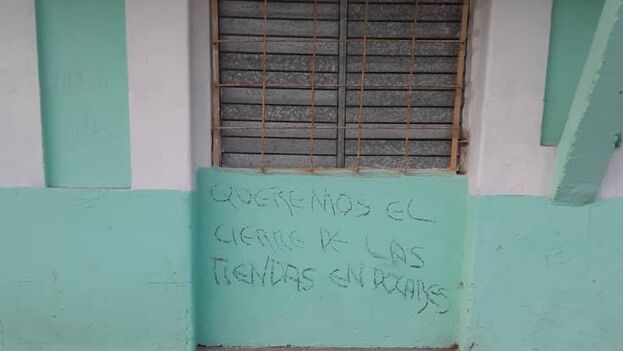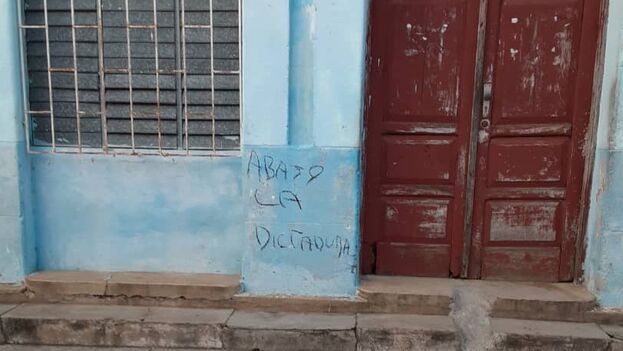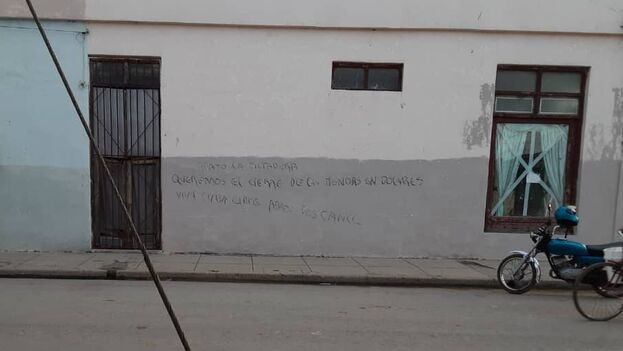
![]() 14ymedio, Luis Daniel Fernández Monzón, Havana, 5 December 2020 — Several graffiti appearing on the walls in the small city of Cruces, in Cienfuegos province, surprised the town’s inhabitants on Thursday. “Down with the dictatorship,” “We want the dollar stores closed,” and “Long Live Free Cuba, down with Dias [sic… it should be ‘Diaz’] Canel,” were the slogans featured.
14ymedio, Luis Daniel Fernández Monzón, Havana, 5 December 2020 — Several graffiti appearing on the walls in the small city of Cruces, in Cienfuegos province, surprised the town’s inhabitants on Thursday. “Down with the dictatorship,” “We want the dollar stores closed,” and “Long Live Free Cuba, down with Dias [sic… it should be ‘Diaz’] Canel,” were the slogans featured.
The graffiti were painted during the night by unknown people on the facades of three houses on José Luis Robau street, at the corner with Paseo de Gómez (El Prado). The photos to illustrate this article were taken minutes before the authorities removed it.
As a consequence, there was a considerable deployment of police forces throughout the morning, a surveillance similar to the one that took place a few days ago in some commercial centers in Havana. With the difference that there are no dollar stores in Cruces at the moment, although it is said that one will open shortly.
The discontent of the population has increased since the Government determined last July to set up stores that sell food and cleaning products — that is basic necessities — but only take payment in freely convertible currency (MLC for its Spanish initials) — that is, foreign currency such as dollars and euros. In addition, shoppers must arrange through a bank to have a special magnetic card that carries the value of currency. (In this way, the State banks get the money before it is even spent.)
The closure of the dollar stores is precisely one of the requests of the San Isidro Movement, which considers that the measure divides society in two: those who have access to dollars and those who do not.

In the afternoon of Thursday, the Cruces authorities organized an “act of redress” in Martí park, “in support of the Socialist Revolution and its leaders” and with songs by Silvio Rodríguez. At no time did the authorities make reference to the graffiti.
“They no longer know what to say, they no longer know what to do,” a resident told 14ymedio. “It is time to make the oppressors tremble. Now it is their turn to be afraid!”
The local media Radio Cruces reported a “revolutionary tángana” organized by the authorities in the municipality after the incidents. “Patriotic voices were raised in the Committee for the Defense of the Revolution number 7, in zone 21, located in the San José Popular Council of the municipality of Cruces,” the station explained.
“The counterrevolutionaries will not have any platform here, the counterrevolutionaries will not have the right to campaign against the Revolution here. It is over,” declared Elianis Sarduy, a student, at the official ceremony.

This type of convocation has been taking place throughout the country after the hunger strike of several members of the San Isidro Movement and the protest of hundreds of artists in front of the Ministry of Culture in Havana, on November 27. The first of these “tánganas” took place in the Trillo Park of the Cuban capital and was attended by president Miguel Díaz-Canel.
The word “tángana” refers to student demonstrations against dictator Gerardo Machado in 1930, fueled by outrage at the death of 20-year-old leader Rafael Trejo. The pickets of young people gathered in the streets and squares to demand Machado’s resignation and their actions led to the end of his mandate.
____________
COLLABORATE WITH OUR WORK: The 14ymedio team is committed to practicing serious journalism that reflects Cuba’s reality in all its depth. Thank you for joining us on this long journey. We invite you to continue supporting us by becoming a member of 14ymedio now. Together we can continue transforming journalism in Cuba.
